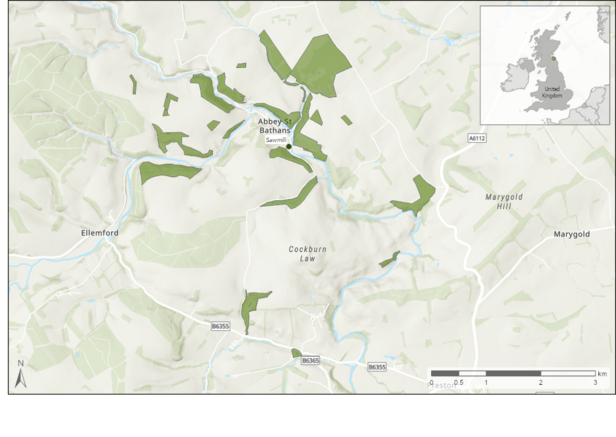
C12 Dobie family ¶
Abbey St Bathans – Scotland ¶


General information on the forests of the Abbey St Bathans.
| Forest community | A patchwork of small stands with predominantly coniferous single-aged, single-species sub-compartments (0.5 - 1 ha) on valley sides and as shelter-belts on the hill-tops, and ancient oak woodlands on the steepest slopes. |
| Total forest area | 278 ha, divided over: – 210 ha of conifer dominated stands – 22 ha of ancient oak woodlands (of which 15 ha is designated as a Site of Special Scientific Interest) – 16 ha of recently established native woodland to expand and connect the ancient woodland sites – 30 ha of open land and set asides within larger woodland areas |
| Main management type | – Transition from clearcutting to continuous cover forestry with small gaps (<0.5 ha) and single tree selection of the conifer dominated stands – Based on the yield class, thinning every 4–5 years, slightly over the annual increment rate to bring stocking down – Steady small-scale regeneration (<0.25 ha) of the ancient oak woodlands |
| Standing volume | – Averages 550 m³/ha in the conifer stands. – 75 m³/ha in the ancient oak woodland |
| Annual increment | – Averages roughly 3 m³/ha in the conifer stands – 1–2 m³/ha in the ancient oak woodland |
| Annual harvest volume | – 700 m³/year in the conifer stands – 0 m³/ha/year in the ancient oak woodland. Plans to allow for more light in some areas to enhance regeneration |
| Ownership | Private family owned and managed |
| Climate | – approx. 7.7 °C mean annual temperature; – approx. 760 mm mean average precipitation |
| Altitude | Between 120–250 meters above sea level |
| Soil and geology | – Brown earth soils of moderate fertility with forests planted on the poorer and steeper sites. – The top soil is thin, resting on bedrock made up of Gala group greywack – rock fragments of hard sandstone. |
| Protected area | – Most of the 22 ha of ancient oak woodland is designated as Site of Special Scientific Interest (SSSI). – Smaller self-imposed retention areas of open land and edges in woodlands are maintained for diversity and conservation. They amount to about 32 ha in total. |
| Protective function | None |